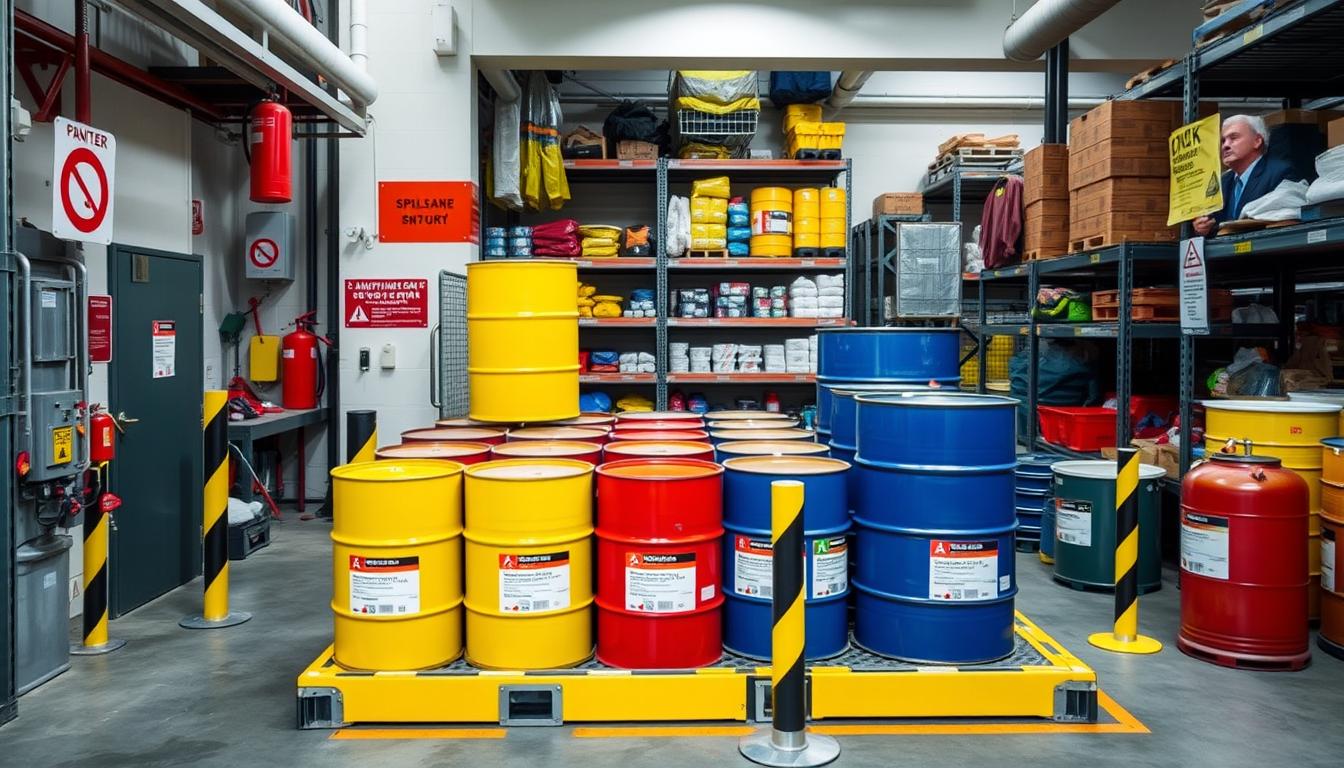Ensuring safety in hazardous storage is paramount to avoid accidents and adhere to regulations. A well-organized system for storing hazardous materials is vital. It protects individuals, the environment, and facilities from potential dangers. In the United States, many companies are enhancing their hazardous storage facilities. They focus on a safety-first approach to hazardous storage.
A safety organization dedicated to hazardous storage evaluates various factors. These include the types of hazardous materials stored, the associated risks, and mitigation measures. Proper storage procedures, employee training, and safety equipment are key. By prioritizing safety, companies can lower accident risks and meet regulatory standards. This is crucial for maintaining a safe and healthy workplace.
Effective hazardous storage demands a deep understanding of stored materials and their risks. Companies adopting a proactive stance in hazardous storage can significantly reduce accident risks. Thus, having a safety organization that emphasizes hazardous storage is essential. It prevents accidents and ensures a safe work environment.
Key Takeaways
- Implementing a safety-first approach to hazardous storage is critical to preventing accidents and ensuring compliance with regulations.
- A well-organized system for hazardous storage is essential to protecting people, the environment, and facilities from potential hazards.
- Proper hazardous storage procedures, training, and safety equipment are necessary to mitigate risks associated with hazardous materials.
- Companies must prioritize safety in hazardous storage to reduce the risk of accidents and maintain a safe working environment.
- Understanding the types of hazardous materials being stored and the potential risks associated with them is crucial for effective hazardous storage.
- A safety organization focused on hazardous storage can help companies ensure compliance with regulations and maintain a safe working environment.
Understanding Hazardous Storage Fundamentals
Proper hazardous storage is key to reducing risks and meeting regulatory standards. To craft effective storage plans, grasping the nature of hazardous materials, their categorization, and risk assessment basics is crucial. Chemical storage facilities must be equipped to manage various hazardous substances, such as flammable liquids, corrosive agents, and toxic chemicals.
The Globally Harmonized System of Classification and Labelling of Chemicals (GHS) is a prevalent classification framework for hazardous materials. It outlines a method for categorizing chemicals by their hazards, offering guidance on labeling and packaging. Mastery of the GHS classification system is essential for the safe storage and handling of hazardous materials.
Types of Hazardous Materials
- Flammable liquids
- Corrosive substances
- Toxic chemicals
- Reactive materials
Classification Systems
The GHS classification system categorizes hazardous materials by their hazards. It serves as a framework for labeling and packaging, ensuring safe handling and storage.
Risk Assessment Basics
Risk assessment is a fundamental aspect of hazardous storage. It entails identifying potential hazards, evaluating the risks they pose, and implementing measures to reduce those risks. Chemical storage facilities must regularly conduct risk assessments to validate the efficacy of their storage methods and adherence to regulations.
By mastering the basics of hazardous storage and chemical storage, facilities can devise strategies that minimize risks and adhere to regulatory standards. This entails proper labeling and packaging, regular risk assessments, and employee training on handling and storing hazardous materials.
Essential Safety Requirements for Chemical Storage
When it comes to chemical storage, safety is paramount. Proper storage and handling of chemicals can prevent accidents, injuries, and environmental damage. The use of safety cabinets is a critical safety requirement. These cabinets are designed to store hazardous materials, such as flammable liquids and corrosive substances, in a safe and controlled environment.
Some key considerations for chemical storage include:
- Secondary containment measures to prevent spills and leaks
- Proper labeling and signage to identify the contents of each container
- Regular inspection and maintenance of storage facilities and equipment
A well-designed chemical storage system should include safety cabinets tailored to the type of chemical stored. For instance, flammable liquids should be stored in cabinets designed to prevent ignition and explosion. By adhering to these safety requirements, facilities can minimize risks associated with chemical storage and ensure a safe working environment for employees.
In addition to safety cabinets, facilities must implement proper ventilation and environmental control systems. This prevents the accumulation of hazardous fumes and vapors. The use of fans, vents, and air purification systems is essential to maintain a safe and healthy environment. By prioritizing safety and following these essential safety requirements, facilities can ensure compliance with regulations and protect the health and well-being of employees and the environment.
| Chemical Storage Requirement | Description |
|---|---|
| Secondary Containment | Measures to prevent spills and leaks |
| Proper Labeling | Clear identification of container contents |
| Safety Cabinets | Designed to store hazardous materials safely |
Designing Your Hazardous Storage Facility
Designing a hazardous storage facility requires careful consideration of several key factors. The layout must be planned to minimize risks. This includes storing incompatible materials in separate areas to prevent accidents. Temperature control systems are also crucial for materials sensitive to heat or cold, as improper storage can lead to degradation or explosions.
Effective ventilation systems are vital in hazardous storage facilities. They prevent the accumulation of toxic fumes and maintain a safe atmosphere. The facility must also have emergency response infrastructure. This includes fire suppression systems, spill containment measures, and emergency showers. These features ensure a safe and compliant hazardous storage environment.
Some key considerations for designing a hazardous storage facility include:
- Separate storage areas for incompatible materials
- Temperature control systems for sensitive materials
- Effective ventilation systems to prevent toxic fume accumulation
- Emergency response infrastructure, including fire suppression systems and spill containment measures
By carefully planning and designing a hazardous storage facility, facilities can minimize risks. This ensures a safe and compliant environment for storing hazardous materials. Proper hazardous storage and ventilation systems are critical to preventing accidents and protecting people and the environment.
| Facility Feature | Importance |
|---|---|
| Separate storage areas | High |
| Temperature control systems | Medium |
| Effective ventilation systems | High |
| Emergency response infrastructure | High |
Ventilation and Environmental Control Systems
Proper ventilation systems are essential in hazardous storage facilities. They prevent the buildup of hazardous vapors, ensuring a safe environment. These systems significantly reduce inhalation hazards, crucial for personnel safety and regulatory compliance. Effective storage compliance hinges on the careful design of ventilation systems and environmental controls. This prevents contamination and minimizes risks.
When considering ventilation systems, several factors are important:
- Airflow rates and patterns to prevent the accumulation of hazardous vapors
- Filter systems to remove contaminants and particles from the air
- Monitoring systems to detect any changes in air quality or ventilation system performance
Implementing effective ventilation systems and environmental controls is key. It ensures storage compliance and maintains a safe working environment. This is vital for protecting personnel, preventing accidents, and reducing environmental contamination risks.
Safety Cabinet Selection and Implementation
Storing dangerous goods requires safety cabinets to ensure a secure and compliant facility. Choosing and implementing these cabinets is critical for safe hazardous material storage. It’s essential to consider the types of hazardous materials and their specific safety needs.
Safety cabinets are designed to securely store dangerous goods, including flammable and corrosive substances. To meet these needs, selecting cabinets that fit the materials’ requirements is necessary. For instance, flammable liquids need cabinets with ventilation and fire-resistant materials.
- Material compatibility: Ensure the cabinet is made from materials that are compatible with the hazardous materials being stored.
- Ventilation: Choose cabinets with adequate ventilation to prevent the buildup of vapors and fumes.
- Fire resistance: Select cabinets with fire-resistant materials to prevent the spread of fires.
By selecting and implementing safety cabinets carefully, facilities can ensure the safe storage of dangerous goods. This approach protects employees and the environment, preventing accidents and reducing liability. With the right cabinets, facilities can store hazardous materials safely, meeting all necessary safety requirements.
| Safety Cabinet Type | Features | Applications |
|---|---|---|
| Flammable Liquid Cabinet | Ventilation, fire-resistant materials | Flammable liquids, solvents |
| Corrosive Substance Cabinet | Chemical-resistant materials, spill containment | Corrosive substances, acids |
| General Purpose Cabinet | Secure storage, locking mechanism | General hazardous materials, supplies |
Regulatory Compliance and Documentation
Ensuring storage compliance is vital for any entity handling hazardous materials. It demands strict adherence to laws, like OSHA standards, to ensure a secure workplace. A well-organized safety organization is key for meeting these standards and keeping records accurate.
To meet regulatory requirements, organizations must:
- Establish a safety management system with procedures for hazardous materials handling
- Offer regular training on safety protocols and emergency response plans
- Keep detailed records of hazardous material storage, handling, and disposal
By focusing on storage compliance and safety organization, companies can lower accident risks. This leads to better efficiency, lower costs, and a strong reputation.
It’s crucial to remember that regulatory compliance is a continuous effort. Organizations must constantly monitor and assess their compliance. They must also adapt to new regulations and update their safety systems.
Employee Training and Safety Protocols
Effective employee training is key to ensuring the safe handling, storage, and disposal of hazardous materials. A well-structured training program educates employees on the risks of hazardous storage and how to mitigate them. This approach reduces accidents and ensures adherence to regulatory standards.
A comprehensive training program should cover hazardous material handling, emergency response, and spill prevention. Employees must learn about personal protective equipment, fire safety, and first aid. Regular drills and simulations prepare employees for emergencies and enhance their response capabilities.
- Initial training for new employees
- Refresher training for existing employees
- Specialized training for employees handling specific types of hazardous materials
- Documentation of all training sessions
Investing in employee training and safety protocols minimizes risks in hazardous storage. It ensures a safe work environment, protecting employees and preventing environmental damage. It also reduces financial costs related to accidents and non-compliance.
| Training Program | Frequency | Duration |
|---|---|---|
| Initial Training | Once | 2 days |
| Refresher Training | Annually | 1 day |
| Specialized Training | As needed | Varies |
Maintenance and Inspection Schedules
Regular maintenance and inspections are vital for the integrity of hazardous storage facilities and equipment. They prevent accidents and ensure compliance with regulations. By setting up regular maintenance and inspections, facilities can spot issues early, avoiding major problems.
Key aspects of maintenance and inspection schedules for chemical storage facilities include:
- Regular checks of storage containers and equipment to ensure they are in good condition
- Inspections of ventilation systems to ensure proper airflow and prevent the buildup of hazardous fumes
- Testing of emergency response equipment, such as fire extinguishers and spill response kits
By focusing on maintenance and inspections, facilities can significantly reduce accident risks. This is crucial for hazardous storage facilities, where accidents can have severe consequences. Regular maintenance and inspections protect employees, the environment, and the facility’s reputation.
Remember, regular maintenance and inspections are key to safe and compliant chemical storage facility operations. By making these tasks a priority, facilities can prevent accidents, reduce risks, and safeguard their assets.
| Maintenance Task | Frequency |
|---|---|
| Storage container inspections | Monthly |
| Ventilation system checks | Quarterly |
| Emergency response equipment testing | Annually |
Spill Prevention and Response Strategies
Preventing spills is vital in hazardous storage environments. Even with precautions, accidents can happen. Thus, having a response plan is crucial. This includes using safety cabinets for hazardous materials and setting up containment systems to stop spills from spreading.
Containment systems play a key role in spill prevention. They range from simple spill trays to complex, fully enclosed containers. The aim is to contain the spill and simplify cleanup. It’s also vital to have clean-up procedures ready. This includes having the right equipment and training to handle spills efficiently.
Containment Systems
- Spill trays and pallets
- Secondary containment systems
- Portable containment systems
Spill reporting is another critical aspect. It involves notifying the proper authorities and detailing the spill. With a solid plan and adherence to procedures, businesses can reduce spill risks and meet regulatory standards.
Clean-up Procedures
Clean-up procedures are essential for quick and effective spill response. They require the right equipment and training. By following these steps, businesses can reduce environmental harm and ensure regulatory compliance.
Technology Integration in Hazardous Storage
Technology is crucial for improving safety and compliance in hazardous storage facilities. It streamlines operations, lowers risks, and ensures a safer space for employees and the community. In hazardous storage, technology manifests in monitoring systems, inventory management, and digital documentation.
For hazardous storage, ventilation systems are key to safety. They prevent toxic fume buildup and explosion risks. Technology integration in these systems allows for air quality monitoring and control, keeping the environment safe for workers.
Monitoring Systems
Monitoring systems are vital in hazardous storage technology. They detect leaks, spills, or hazards in real-time, enabling quick responses. Sensors and alarms help identify risks, allowing for immediate action to prevent accidents.
Inventory Management
Technology significantly impacts inventory management in hazardous storage. Digital tools track and manage hazardous materials, ensuring correct quantities and procedures. This reduces accident risks and keeps facilities within legal bounds.
Digital Documentation
Digital documentation completes the technology integration in hazardous storage. Digital tools manage documents, keeping records up-to-date and accessible. This streamlines compliance, reduces administrative work, and boosts efficiency.
In summary, technology integration is crucial for enhancing safety, compliance, and efficiency in hazardous storage facilities. By using monitoring systems, inventory management, and digital documentation, facilities can minimize risks, optimize operations, and ensure a safer environment for all.
Cost Considerations and ROI
Investing in a hazardous storage system might seem expensive at first. Yet, the long-term benefits and potential return on investment (ROI) are crucial. The costs of not following hazardous storage regulations can be much higher than the initial cost of a proper system. In the United States, companies that don’t follow storage compliance rules face hefty fines and penalties.
Key costs for hazardous storage solutions include:
- Initial investment in storage facilities and equipment
- Ongoing maintenance and inspection costs
- Training and personnel costs for employees handling hazardous materials
Yet, a well-designed hazardous storage system can offer significant ROI. This comes from:
- Reduced risk of accidents and injuries
- Improved compliance with regulatory requirements
- Enhanced operational efficiency and productivity
A study by the Occupational Safety and Health Administration (OSHA) shows a dollar invested in workplace safety can save up to $6 in injury and illness costs. By investing in a proper hazardous storage system, companies can lower their risk of non-compliance. They also improve their financial health.
| Cost Consideration | Initial Investment | Ongoing Costs | Potential ROI |
|---|---|---|---|
| Storage Facilities | $10,000 – $50,000 | $1,000 – $5,000 per year | 10% – 20% per year |
| Equipment and Training | $5,000 – $20,000 | $500 – $2,000 per year | 5% – 10% per year |
By weighing the costs and potential ROI of hazardous storage solutions, companies can make smart investment choices. This is crucial for hazardous storage and storage compliance.
Conclusion: Ensuring Long-term Safety and Compliance
A well-organized hazardous storage system is crucial for a safety-first approach. Understanding hazardous materials, following strict safety rules, and having solid storage and emergency plans are key. These steps protect employees, facilities, and communities for the long haul.
Success in hazardous storage management comes from being proactive and vigilant. Regular checks, thorough employee training, and using the latest monitoring and inventory tech are vital. They help keep up with changing rules and reduce risks. Prioritizing safety and following regulations not only protects your business but also enhances your reputation as a responsible company.
As you tackle the challenges of hazardous storage, keep your focus on safety and continually improve your systems. A culture of safety and ongoing improvement will reward you in the long term. This way, you safeguard your business, your team, and the communities you interact with.


